The LG XBOOM Go PL5 sits in the middle of the new range of speakers from LG. It’s a substantial step up both in size and sound from the PL2 I looked at previously, but still compact and a fair bit smaller than the largest PL7 I’ll be looking at separately.
All three speakers share the same design and they all have their audio tuned by Meridian like their predecessors, the PK series I looked at last year.
It has up to 18 hours of battery life, IPX5 water resistance, and USB-C charging. It can be paired with multiple speakers, has LED lighting that will synchronize to the beat of your music and an accompanying app to customise and control it.
It’s currently around £100 or $125, but check the links underneath the article for the latest prices, since they seem to vary hugely.
I’ll be running through its features before comparing how it sounds to two of its rivals: the JBL Flip 4 and the Anker Soundcore Boost – both similar in size. I’ll also compare it to last year’s LG PK5 and its two siblings the PL2 and PL7, so let’s take a closer look.
Overview

Inside the box you get the speaker itself, a white USB-A to USB-C charging cable and an instruction manual. There’s no 3.5mm auxiliary cable.
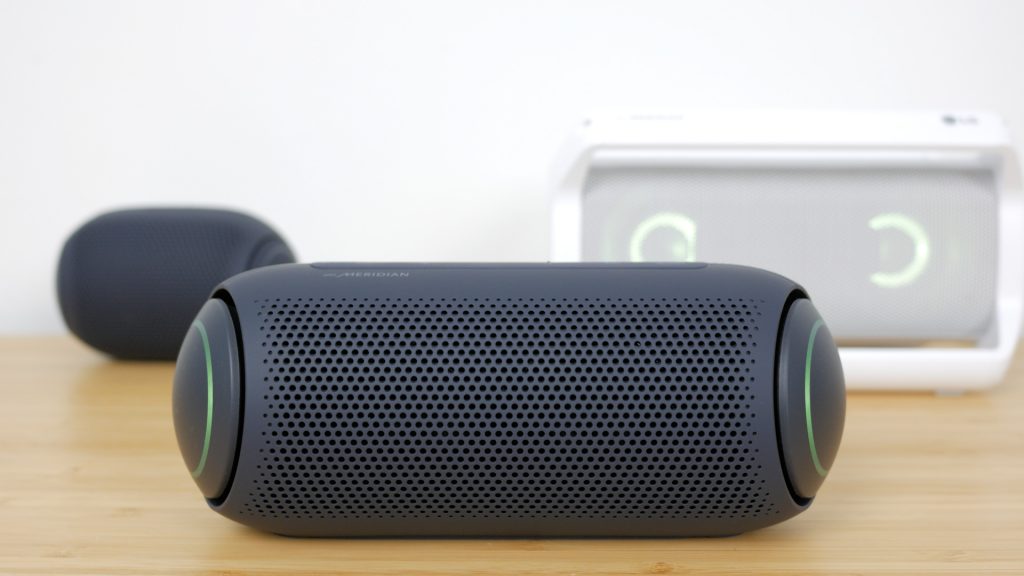
Although a fair bit larger than the LG PL2, this is still a compact speaker and much smaller than last year’s PK5. It measures 201mm x 79 mm X 79 mm and weighs 627g – almost half the weight of the PK5 but heavier than the JBL and Anker speaker.
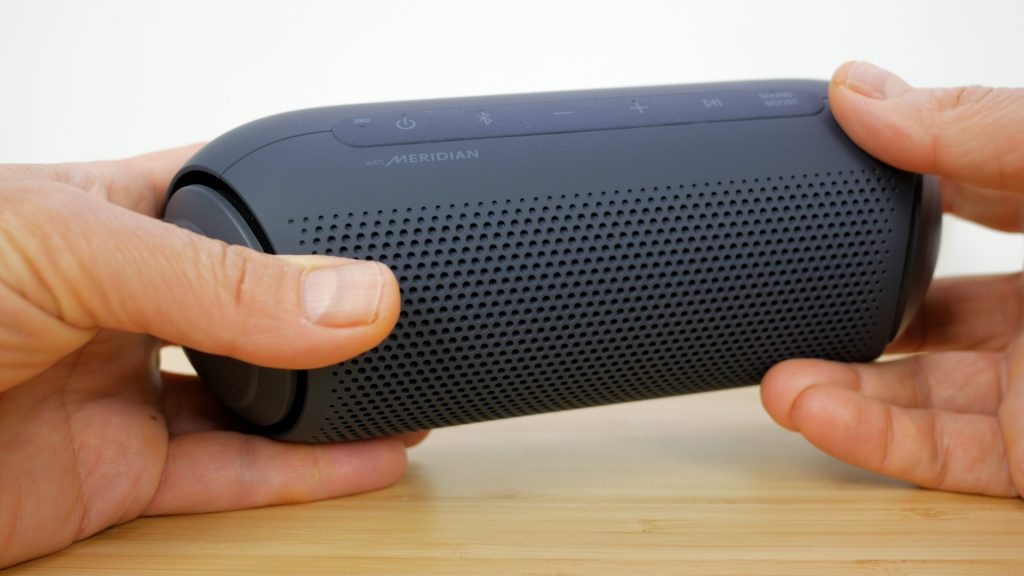
Like all the LG speakers I’ve tested, it’s very well made, with a matte grey finish that doesn’t attract fingerprints. There’s no creaking however hard you twist or squeeze it. The rounded design is more contemporary than the PK5 and is carried through the whole PL series of speakers.

The front, plain speaker grille is surrounded by dual passive radiators which both have multicoloured LED lighting.

The top of the speaker houses the controls. There’s the battery status LED which is missing on the PL2, the power button and Bluetooth pairing buttons both with their status LEDs, volume controls and the pause | play button. A double press skips forward a track and a triple press skips back. The button also answers and ends phone calls.
Finally there’s the Sound Boost button with its accompanying LED, which is on by default. Like the PL2 there’s a raised dimple over the volume up button which is useful for feeling the main controls without having to look at the speaker.
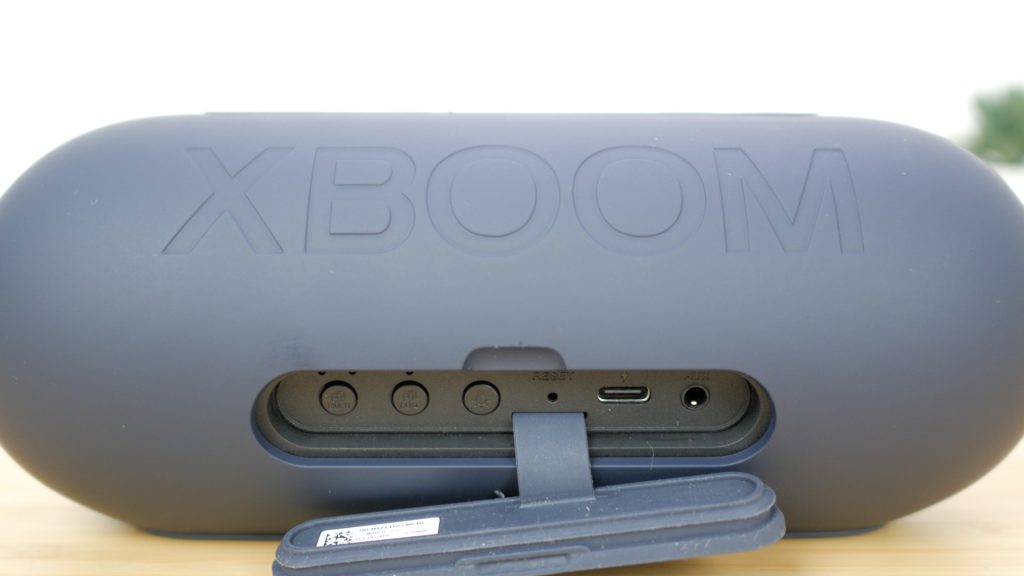
The back of the speaker has the embossed XBOOM branding and a rubber flap concealing the Multi mode and Dual mode pairing buttons with their status LEDs for pairing multiple speakers, a button to cycle lighting modes or switch the LED lighting off, the reset button, the USB-C charging port and the 3.5mm audio-in port. This flap needs to be fully seated to maintain its IPX5 water resistance rating.
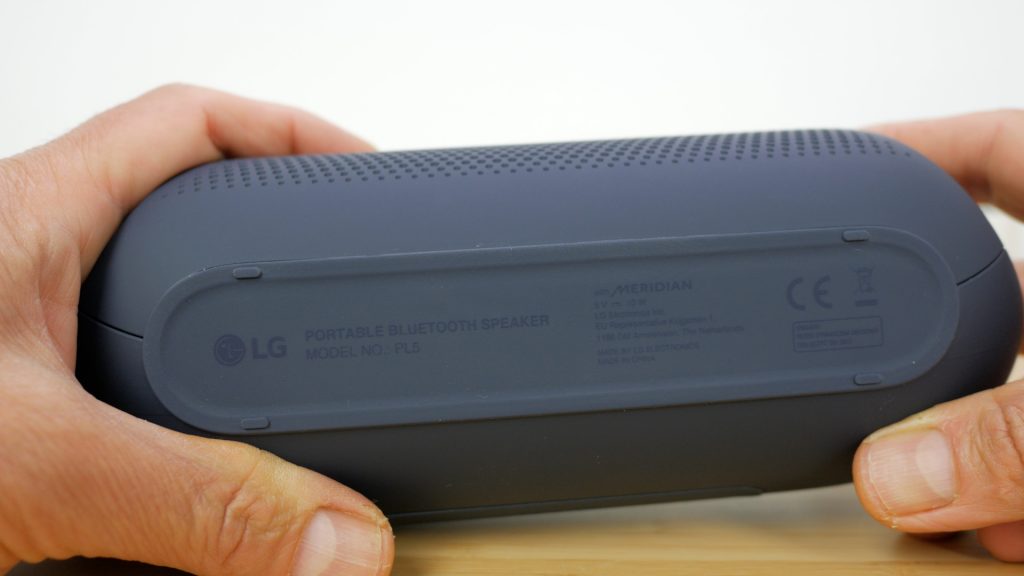
The bottom of the speaker has a small flat base with four tiny rubber feet to dampen any vibrations. It’s more stable than the PL2, but can still roll if you don’t place it down carefully.

To charge the speaker you need to use a USB-A to USB-C cable like the one supplied – a dual ended USB-C cable won’t work.

The battery status LED lights red whilst charging and then turns green before turning off once fully charged.

The integrated 3900mAh or 14.8Wh battery takes up to 4 hours to charge from completely flat, charging at a decent 1.5A. I did get a high frequency hum charging the speaker. It’s not particularly loud, but noticeable in a quiet room.
The battery status LED shows the charge status briefly when you turn the speaker on. You can check the status any time with a 2 second press of the power button with the speaker on or using your phone.

When you turn the speaker on with a single press of the power button for the first time the Bluetooth LED will flash. Connect to LG-PL5(XX) in your Bluetooth device settings. The Bluetooth LED goes steady.

You can pair to a maximum of two devices simultaneously. To pair to a second device press and hold the Bluetooth pairing button for 2 seconds until its LED starts flashing and connect your second device.
If you have a second PL5 speaker you can press the Dual button on both speakers to set them up as a stereo pair. You can use the Multi mode button to pair multiple PL5 and PL7 speakers. There won’t be any stereo separation but you can theoretically pair up to 100 speakers.

I couldn’t try out the Dual mode but used the Multi mode to pair the PL5 to a PL7. The process is a little more complicated than it needs to be. You have to press the Multi mode button on both speakers, but you need to choose which speaker will be the master speaker you’ll connect to from your phone. In this case the PL5 is the master speaker. The first LED above the multi-mode button indicates the speaker is the master or Main speaker. On the PL7 in this case, you need to press the Multi mode button twice to make this speaker the slave. The second LED will light up to indicate the PL7 is the Other speaker; in LG’s parlance.
The lighting mode is set by the Main speaker, but I found the volume isn’t synchronized between speakers and controlling the volume from my phone only affected the Main speaker. I had to adjust the volume manually on the second speaker.

This multi-mode feature only works with the PL5 and PL7 and not the PL2 or last year’s PK series which is disappointing.

There is an accompanying LG XBOOM app which is finally also available on iOS – the app was only available on Android with the PK series. This app should make pairing speakers easier, but since the PL5’s latest firmware update the link icon for pairing speakers is missing.
There’s no EQ customisation either, but you can check the battery level, turn Sound Boost on and off and configure the lighting. And you can disable the auto power off features and the audio prompts accompanying turning the speaker on and off and Bluetooth pairing, as well as updating to the latest firmware.
It’s also possible to configure Multi-play mode which by default is set to Private. It’s dependent on device and application, but even in this default mode, you should be able to pause music on one device and start playing on the second paired device. If you turn on Party mode under Settings | Multi-play mode, you don’t need to pause playback to play music on another device, allowing two people to control the speaker at the same time.
Sound quality and performance

The LG PL5 has stereo 45mm mid-range drivers with vibrating dual passive radiators and its 20W of output is pretty loud for a compact speaker, especially with Sound Boost on.
The Sound Boost mode not only makes the speaker louder – but it also makes your music sound brighter too and with a broader range. But some tracks do start to sound a little harsh. This isn’t a particularly subtle EQ setting and for a lot of music I preferred it turned off, so it’s worth experimenting. It will depend a lot on the type of music you listen to.
Overall the speaker has good clarity and the mids in particular sound crisp, even with tracks with plenty of bass, which it handles pretty well. Tracks with sibilant sounds benefit from reducing the volume slightly but considering the size of the speaker it’s hard not to be impressed with how balanced it sounds. To me it sounds richer than the JBL Flip 4, and has more detail than the Anker Soundcore Boost.
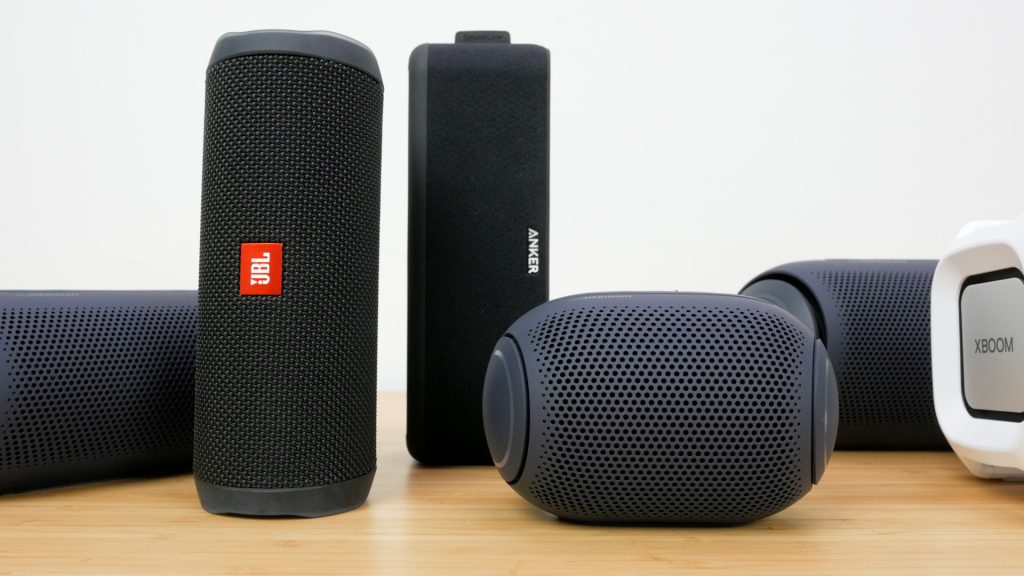
But you can hear for yourself how it sounds in the accompanying video, with Sound Boost on and off and compared to the JBL Flip 4, Anker Soundcore Boost, LG PL2, LG PL7 and last year’s LG PK5 (left to right above). Let me know in the video’s comments which is your favourite. I also have full reviews of many of these speakers playing various tracks, so take a look at the links in the video’s description if you’re interested.
I recorded the sound test with binaural microphones that capture stereo sound, to try and provide the closest representation of what I’m hearing. Please listen to the video sound test with headphones for the best experience.

Audio sync playing back YouTube videos even on iOS which is usually a challenge, was good. There is still a very small delay, but it’s better than most Bluetooth speakers I’ve tested.
Battery life is quoted as a respectable 18 hours – although this is at 50% playback volume, with lighting and Sound Boost off. I still got at least a full day’s usage usually playing back around 70-80% volume with lighting on and Sound Boost on at least half of the time.
The speaker uses the latest Bluetooth 5.0 and range was fairly typical, making it to the end of the next room of my brick built house, around 10 metres away. I didn’t get any interference issues.
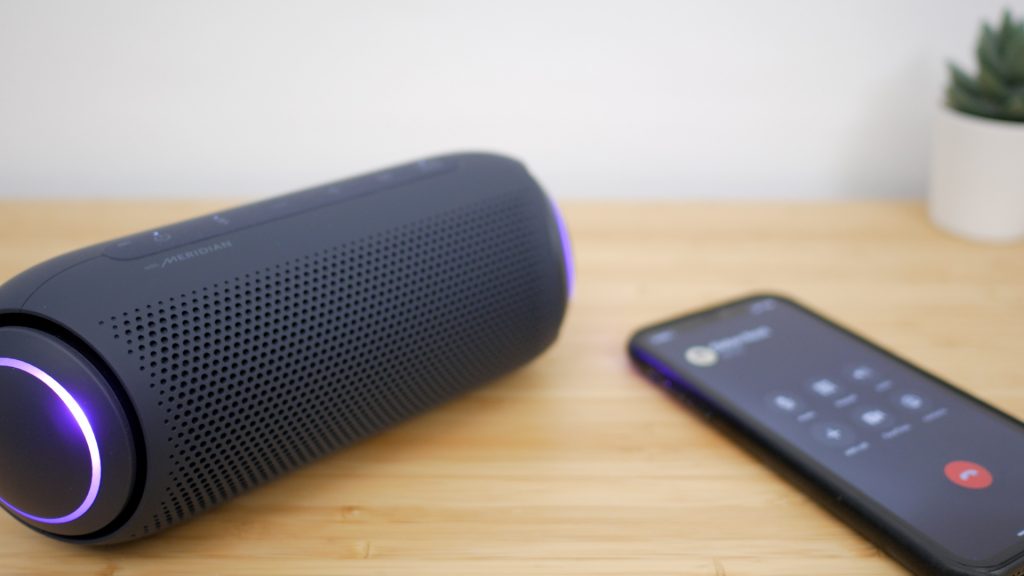
Received phone calls sounded good, but the built in microphone doesn’t have the greatest pickup – significantly worse than the PL2 which is surprising. This mic is also used if you activate your voice assistant with a two second press of the Play | Pause button, but you’ll need to get quite close for Siri or the Google Assistant to understand you. You can listen to the microphone test in the accompanying video.

Since the PK series, LG appear to have dropped support for the higher quality aptX codec, but do support the still higher quality AAC codec. And for the best quality you could always use a 3.5mm cable via the audio-in port.

Like its predecessor the PK5, the speaker has an IPX5 splash proof rating which held up fine in my tests. But I would have liked to have seen a higher IPX7 waterproof rating like the JBL Flip 4, for what could be a very useful travel speaker.
Conclusions
The LG XBOOM Go PL5 is a great all-round portable speaker. It sounds good with well balanced sound, and for its size it’s pretty loud. It has a rich feature set with USB-C charging, IPX5 water resistance, multi coloured lighting and it supports both stereo mode pairing as well as multi mode pairing with up to 100 speakers.

It’s retail price is a little expensive but LG often have promotions on their speakers and if you can pick it for less than £100 or $100 it’s worth serious consideration. I’ll be reviewing the LG PL7 shortly or they’ll be a link on-screen if that review is already out, but this is currently a similar price. If you don’t mind its larger size it has a more full bodied sound, even longer battery life and can charge your USB devices.

The JBL Flip 4 is slightly smaller, has an IPX7 waterproof rating, is usually a little cheaper and JBL Connect+ is a superior way of connecting multiple speakers. But it doesn’t sound quite as rich as the PL5 and it uses older micro USB charging.
And the Anker Soundcore Boost is a good budget option. It doesn’t have the clarity of the LG, but it’s slightly smaller and also has a USB charging port.
I didn’t include the Anker Soundcore Motion+ in the sound test, but at a similar price it’s also worth considering, if you don’t mind a slightly larger speaker. I’ll include it in the PL7 sound test.
Don’t forget to take a look at my YouTube video at the top of the page, and subscribe to my YouTube channel where I’m releasing videos every week on the latest technology and how to get the most out of it. If you tap the bell icon when you subscribe you’ll get a notification as soon as I release a video, and there’ll be a link to my site here for the written article. YouTube is also the best place to leave a comment. I read all of them and respond to as many as I can!
LG XBOOM Go PL5: https://amzn.to/3dapNkd
LG XBOOM Go PL2: https://amzn.to/2SEkbp8
LG XBOOM Go PL7: https://amzn.to/3iIiKjO
Anker Soundcore Boost: https://amzn.to/2I1ZRf6
JBL Flip 4: https://amzn.to/3nC4cGr
LG PK5: https://amzn.to/36QIXKG
Leave a Reply